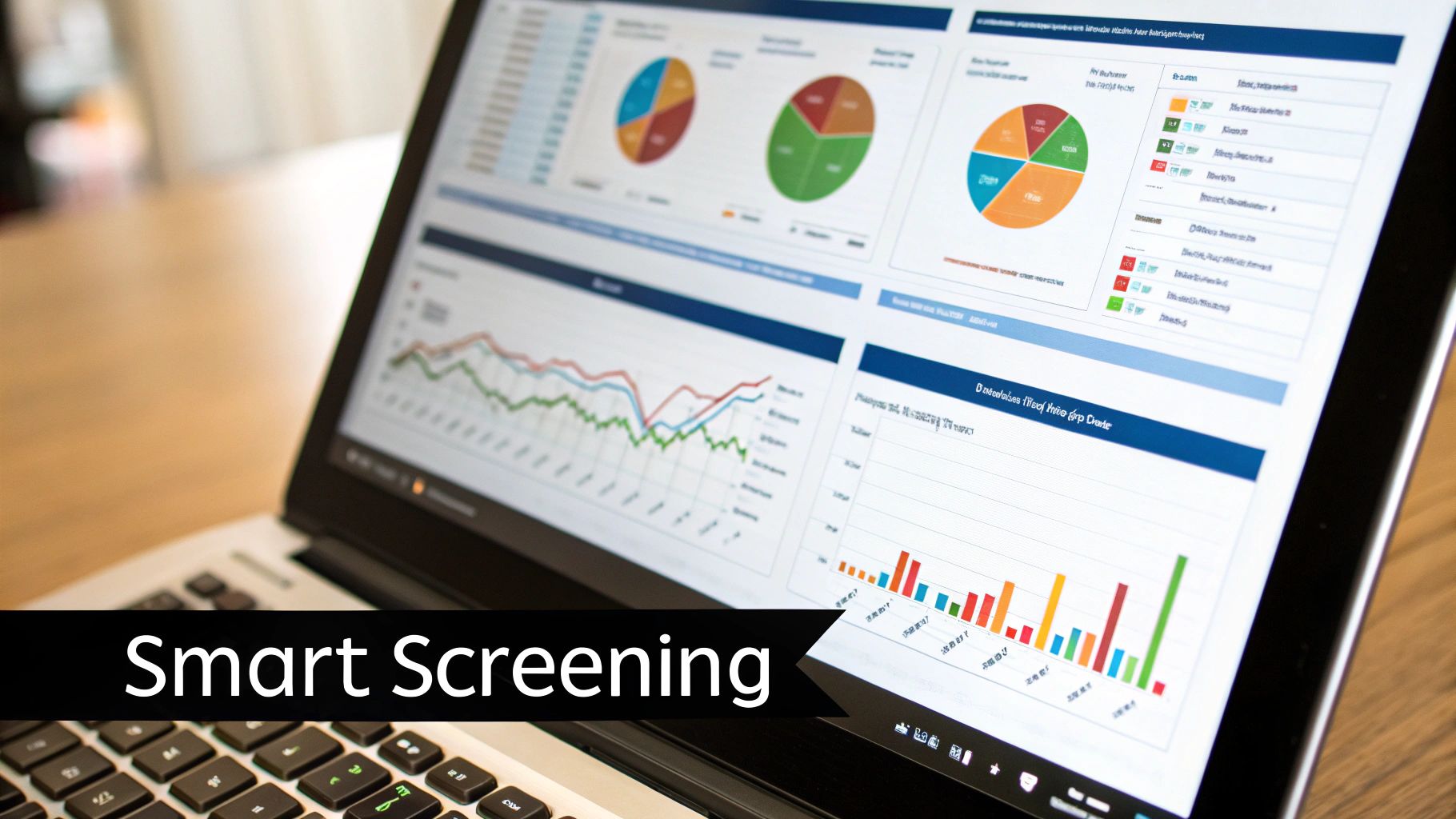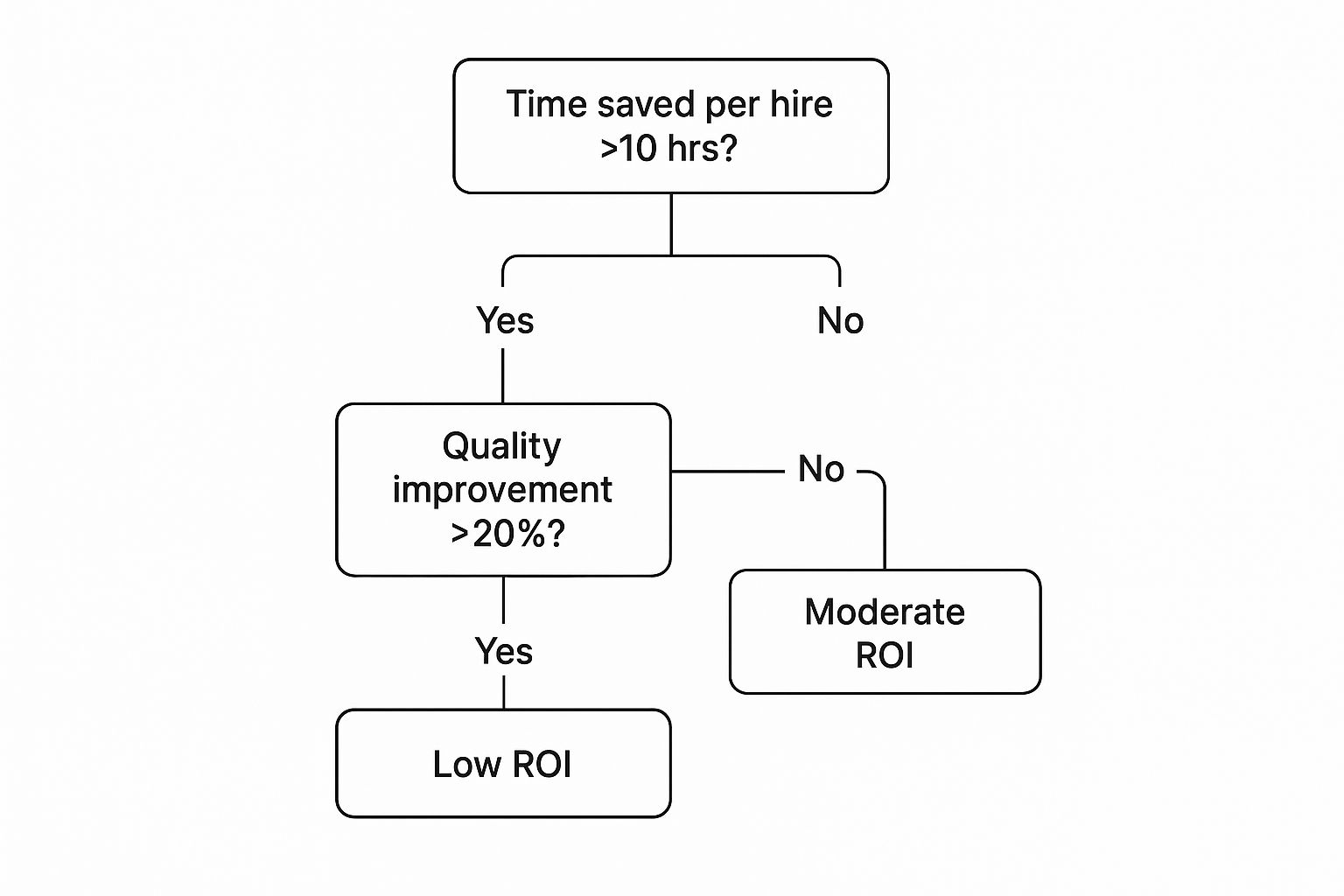Think of recruitment automation software as the conductor of your hiring orchestra. It doesn’t play the instruments, but it coordinates all the repetitive, time-consuming tasks—like sourcing candidates and scheduling interviews—to create a seamless performance. It empowers recruiters by taking administrative burdens off their plates, letting them focus on what truly matters: building genuine connections with top talent.
Why Automated Hiring Is No Longer Optional

Imagine trying to lead an orchestra where every musician plays at their own tempo. That’s traditional hiring in a nutshell—a disjointed process filled with manual data entry, endless email chains, and missed opportunities. This is precisely where recruitment automation software steps in to bring harmony to the chaos.
This technology isn’t about replacing the human touch in recruiting; it’s about amplifying it. By handling the high-volume, low-impact tasks that eat up a recruiter’s day, these platforms solve the core problem of slow, inefficient hiring cycles.
At its heart, recruitment automation is a strategic tool designed to give your team back its most valuable resource: time. It enables recruiters to shift their focus from process management to people engagement.
Adopting these tools is fast becoming standard practice for any business that wants to stay competitive. The market’s rapid growth is a clear signal of a major shift in how companies are approaching talent acquisition.
The Growing Demand for Efficiency
The Indian recruitment software market tells this story perfectly. Valued at USD 88.82 million in 2024, it’s projected to nearly double to USD 163.62 million by 2034. This incredible growth is being fuelled by businesses, especially in the IT and manufacturing sectors, that need to make their hiring workflows more efficient to gain a competitive edge.
This rapid adoption highlights a simple truth: in today’s talent market, speed and precision are everything. Companies can no longer afford the delays and administrative headaches of manual hiring. For example, a well-implemented platform can help with:
- Sourcing and Screening: Automatically scanning job boards and internal databases to find qualified candidates.
- Communication: Sending personalised updates and interview reminders to keep applicants engaged.
- Scheduling: Eliminating the back-and-forth headache of coordinating interview times across multiple calendars.
By automating these steps, you create a smoother, more professional experience for both your hiring team and potential employees. This guide will explore how a modern recruitment platform eases digital hiring, turning it from a logistical nightmare into a strategic advantage. For any organisation serious about attracting and securing the best people, it’s an essential move.
Exploring Core Automation Capabilities

To really see what recruitment automation software can do, we need to lift the bonnet and look at the engine. These platforms aren’t just fancy digital filing cabinets; they’re dynamic tools built to handle specific, high-volume hiring tasks with speed and accuracy. Each feature is designed to fix a common bottleneck in the hiring process.
Think of this software as a super-efficient digital assistant for your talent team. Its main job is to take over the predictable, repetitive work. This frees up your recruiters to focus on what humans do best: building relationships, making strategic decisions, and interviewing top contenders.
These core capabilities don’t work in isolation. They connect to create a smooth, unified workflow, transforming a messy manual process into a seamless journey for both your team and your candidates.
Automated Candidate Sourcing
The search for great talent often starts with the soul-crushing task of sifting through countless job boards and social networks. Automated sourcing acts like a tireless scout for your team. It constantly scans job sites, professional networks like LinkedIn, and even your own internal database for profiles that fit your exact needs.
Instead of a recruiter burning hours on manual searches, the software does all the heavy lifting. This means your team gets a steady flow of relevant candidates to engage with, minus the upfront grind. And because it works 24/7, you’ll never miss a great profile just because it was posted after business hours.
Intelligent Resume Screening
Once the applications start flooding in, the real work begins: sorting through hundreds, or even thousands, of CVs. This is where intelligent screening completely changes the game. Using AI, the software analyses resumes by looking far beyond simple keywords.
It can understand context, figure out what different job titles actually mean, and spot relevant skills even if they aren’t spelled out perfectly. This leads to a much higher-quality shortlist for your recruiters, saving a huge chunk of the 40% of their time typically lost to manual screening.
This intelligent filtering doesn’t just save time—it also helps reduce human error and unconscious bias. By zeroing in on objective skills and experience, it helps make sure the most qualified people move forward, no matter their background.
This capability is a massive reason for the growth of AI-powered tools in hiring. In India, for example, the AI Recruitment market is expected to more than double, jumping from USD 43.2 million in 2024 to USD 90.6 million by 2035. This boom is largely thanks to the wide adoption of AI for sourcing and screening. You can read more about the rise of AI in Indian recruitment on marketresearchfuture.com.
Seamless Interview Scheduling
Trying to coordinate interview times between candidates, hiring managers, and recruiters often feels like a frustrating game of email tennis. Automated interview scheduling puts an end to that chaos.
The software simply syncs with everyone’s calendars and shows candidates the available slots. They pick a time that works for them, and the system automatically sends confirmations, calendar invites, and reminders to everyone involved. This one simple function can give a busy recruiter back several hours every week.
Here’s a quick look at how it helps:
- Stops Delays: Prevents you from losing top talent because scheduling took too long.
- Improves the Experience: Candidates love the convenience of scheduling their own interviews.
- Minimises Mistakes: Eliminates the risk of double-booking or other calendar mix-ups.
Automated Candidate Communication
Keeping candidates in the loop is essential for a good experience, but it’s nearly impossible to do manually when you’re dealing with hundreds of applicants. Recruitment automation software handles this by sending timely, personalised messages at every step.
From acknowledging an application to sending rejection emails or pre-interview reminders, these automated touchpoints make sure no one is left wondering what’s happening. This consistent communication strengthens your employer brand and shows respect to every single applicant, even those who aren’t the right fit this time. It’s a simple way to build a strong talent pipeline for the future.
Key Features of Recruitment Automation Software
To bring it all together, here’s a quick summary of the core capabilities and the direct value they add to your hiring process.
| Feature | Description | Primary Benefit |
|---|---|---|
| Automated Sourcing | Continuously scans various channels to find candidates matching job criteria. | Fills the talent pipeline with relevant candidates without manual effort. |
| Intelligent Screening | Uses AI to analyse and shortlist the most qualified resumes from a large pool. | Saves massive amounts of time and reduces unconscious bias in selection. |
| Interview Scheduling | Integrates with calendars to allow candidates to self-schedule interviews. | Eliminates back-and-forth communication and speeds up the hiring process. |
| Candidate Communication | Sends automated, personalised emails at key stages of the recruitment process. | Improves the candidate experience and strengthens the employer brand. |
Each of these features tackles a real-world problem, working together to make your recruitment process faster, fairer, and far more effective.
The Business Impact of Automated Recruiting

While the individual bells and whistles of recruitment automation are impressive, their real worth shows up on the balance sheet. Bringing this kind of technology into your process isn’t just about modernising for the sake of it; it’s a strategic play that directly affects your bottom line, brand reputation, and your very ability to snag top talent.
The first thing you’ll notice is a huge weight lifted off your team’s shoulders. When you automate repetitive tasks like screening, scheduling, and sending out routine emails, you give your talent acquisition specialists their most valuable resource back: time. They can finally shift their focus from administrative busywork to the human side of hiring—building relationships, negotiating offers, and strategic talent mapping. That’s where the magic really happens.
Recruitment automation transforms your hiring function from a cost centre into a strategic growth driver. It allows you to build a more agile, responsive, and effective talent acquisition engine that directly supports business objectives.
This shift isn’t just a feeling; it’s something you can measure. From slashing hiring timelines to lowering costs and, most importantly, improving the quality of people you hire, the impact is both significant and visible. In a market where skills are scarce, this becomes a powerful competitive advantage.
Drastically Reduced Time to Hire
In today’s talent market, speed is non-negotiable. The best candidates aren’t just sitting around; they’re often off the market in a matter of days. A slow, clunky hiring process means you’re consistently losing out to the competition. Recruitment automation smashes through the bottlenecks that cause these delays.
Think about it: automated scheduling wipes out days of back-and-forth emails just to find a time slot. AI-powered screening can produce a high-quality shortlist in hours, not days. This acceleration means you can get promising candidates from application to offer before your competitors have even finished their initial review. In fact, studies show that using an Applicant Tracking System (ATS) with automation can cut hiring cycles by a staggering 60%—a massive edge for any growing business.
Significant Decrease in Cost per Hire
Let’s be honest, hiring is expensive. When you add up recruiter salaries, job board advertising, and administrative overheads, the numbers can be eye-watering. Recruitment automation software tackles this head-on by making the entire process far more efficient, leading to big cost savings. It’s not uncommon for automation to reduce the cost-per-hire by up to 30%.
Where do these savings come from?
- Reduced Recruiter Hours: With less time spent on manual chores, you need fewer person-hours to fill each role.
- Optimised Ad Spend: Analytics help you pinpoint which job boards and channels are actually delivering results, so you can stop pouring money down the drain.
- Lower Administrative Costs: Automated workflows cut down on manual data entry and paperwork, trimming associated costs.
This financial impact is a huge reason for the technology’s growing adoption. In India, for example, the recruitment software market was valued at USD 80.0 million in 2024 and is forecast to hit USD 120.0 million by 2033. This growth is being driven by companies that see digital hiring as a way to streamline talent acquisition and boost efficiency. You can find more insights on the Indian recruitment software market on imarcgroup.com.
Enhanced Quality of Hire and Candidate Experience
This might be the most crucial long-term benefit: you end up hiring better people. By casting a wider net with automated sourcing and using AI to screen candidates based on objective skills and qualifications, you strip away unconscious human bias. This leads to more consistent, best-fit hires. It’s no surprise that 62% of teams using an ATS report hiring better-quality people.
At the same time, automation helps you create a stellar candidate experience. Prompt, consistent communication makes applicants feel seen and respected, even if they don’t get the role. This positive interaction does wonders for your employer brand, making it easier to attract great talent down the line and building a pipeline of people who genuinely want to work for you.
How to Choose the Right Automation Software
Picking the perfect recruitment automation software can feel a bit like searching for a needle in a haystack. With countless options on the market, each promising the world, it’s incredibly easy to get overwhelmed. But here’s the secret: the goal isn’t to find the platform with the most bells and whistles. It’s about finding the one that genuinely solves your specific hiring problems.
Before you even think about booking a demo, the first and most important step is to look inwards. Where are the biggest logjams in your current hiring process? Is it the sheer volume of applications you have to sift through? The endless email chains trying to schedule interviews? Or maybe it’s the constant battle to keep your best candidates engaged and interested? Pinpointing these pain points is the foundation of your entire selection process.
Once you know exactly what you’re trying to fix, you can start looking at different platforms with a clear, focused set of criteria. This simple shift in approach turns a daunting task into a structured, confident decision.
Define Your Core Requirements
Think of your core requirements as your non-negotiables. These are the absolute must-haves for any software to even be considered a viable option for your organisation. Getting this right from the get-go will save you a world of pain later, preventing you from sinking money into a tool that just doesn’t mesh with your workflow.
A great way to start is by mapping out your entire hiring process, from the moment a job is posted to the day a candidate signs their offer letter. Identify every single touchpoint and task along the way. This exercise is incredibly revealing and will show you precisely where automation can make the biggest difference for your team.
Focus on these critical areas:
- Integration Capabilities: Your shiny new software needs to play nicely with your existing HR tech stack. This is especially true for your Applicant Tracking System (ATS), if you use one. A tool that operates in its own little bubble just creates more manual work, defeating the entire purpose of automation.
- User Experience (UX): The platform has to be intuitive and easy to use for everyone involved—your recruiters and your candidates. A clunky, complicated interface will just lead to low adoption by your team and a frustrating experience for the very people you’re trying to impress.
- Scalability: Will this software grow with you? You need a platform that can handle a surge in hiring volume without grinding to a halt or hitting you with a massive price increase. Think about where your company will be in two or three years, not just today.
This decision tree gives you a great visual on how different performance improvements can lead to a clear return on investment.

As the graphic shows, even if you only save a small amount of time, a significant jump in the quality of your hires can still deliver a solid ROI. It’s a great reminder that pure efficiency isn’t the only metric that matters.
When you’re weighing your options, a structured checklist can be a lifesaver. It forces you to think critically about what truly matters to your team and keeps your evaluation process consistent across different vendors.
Software Selection Criteria Checklist
| Evaluation Criteria | Importance (High/Medium/Low) | Questions to Ask Vendors |
|---|---|---|
| ATS & HRIS Integration | High | Which systems do you integrate with natively? What does the setup process involve? |
| Candidate Experience | High | Can we customise the candidate communication and application workflow? |
| Ease of Use for Recruiters | High | What does your training and onboarding look like for new users? |
| Reporting & Analytics | Medium | What key hiring metrics can we track? Are dashboards customisable? |
| Scalability & Performance | Medium | What are the performance limits? How does your pricing scale with our growth? |
| Data Security & Compliance | High | How do you ensure compliance with data privacy laws like GDPR? |
| Customer Support | High | What are your support hours and typical response times? Do we get a dedicated contact? |
| Cost & ROI | Medium | What is the total cost of ownership, including implementation and support fees? |
Using a checklist like this ensures you’re asking the right questions from the start and making a decision based on data, not just a slick sales pitch.
Key Questions for Potential Vendors
Once you’ve narrowed your list down to a few top contenders, it’s time to dig in. The way a vendor answers your questions can tell you a lot about their product, their support culture, and their real commitment to your success. Don’t be shy—ask direct, specific questions.
Remember, you’re not just buying a piece of software; you’re starting a partnership. Their approach to customer support and data security is just as crucial as the features they list on their website.
A great vendor should feel like an extension of your team. They should be transparent, responsive, and genuinely invested in helping you solve your recruitment challenges, not just in closing a deal.
Here are some essential questions to have ready:
1. What does your implementation and onboarding process look like? A smooth start is everything. Ask about the training they provide, how they handle data migration, and what a realistic timeline looks like from purchase to actually using the tool.
2. How do you handle data security and privacy compliance? This is a deal-breaker. You need to be certain they follow all relevant regulations and have strong security measures in place to protect your company’s and candidates’ data.
3. What level of customer support can we expect? Get the specifics. Ask about their support channels (phone, email, live chat), guaranteed response times, and whether you’ll have a dedicated account manager to help you.
4. Can you share case studies from companies similar to ours? Seeing how businesses in your industry or of a similar size have found success is powerful proof. It shows the software can deliver tangible results in a real-world setting.
By focusing on your specific needs first and then asking the right questions, you can cut through the noise and confidently choose the recruitment automation software that will truly empower your team and help drive your business forward.
Implementing Your New Software for Success
So, you’ve just invested in a shiny new piece of recruitment automation software. That’s a huge step, but the real journey is just beginning. Think of it like buying a powerful new engine for a race car; it’s just a lump of metal until it’s expertly fitted and tuned. A thoughtful implementation is what truly unlocks the horsepower of your investment, turning a promising tool into a genuine game-changer for your hiring team.
The goal here isn’t just to ‘switch on’ the software. A successful rollout is all about solid planning, crystal-clear communication, and a real focus on helping your team adapt. Without these pieces in place, even the most sophisticated platform can fail to get off the ground, leaving you with frustrated users and a poor return on your investment.
A great implementation isn’t a technical task—it’s a change management project. Success hinges on preparing your people and processes for a new way of working, ensuring the technology serves them, not the other way around.
This process is what makes sure your new tool delivers maximum impact right from day one, getting everyone on board and excited for a more efficient way of working.
Building a Realistic Implementation Plan
One of the most common pitfalls is rushing the launch without a clear roadmap. To sidestep this, start by creating a phased implementation timeline. Breaking the entire process down into smaller, manageable chunks prevents everyone from feeling overwhelmed and gives you room to make adjustments as you go.
Your plan needs to clearly map out key milestones, assign who’s responsible for what, and set achievable deadlines for each stage. Crucially, don’t forget to build in a little buffer time for unexpected hiccups, because they almost always pop up.
A solid implementation plan usually includes these key phases:
1. Project Kick-off and Team Alignment: Get all the key players in a room—recruiters, hiring managers, IT, the lot. This is where you define your goals and what success will look like, making sure everyone is pulling in the same direction.
2. Data Migration and System Configuration: This can be the most technical part of the puzzle. You’ll need to work closely with your software vendor to cleanly transfer your existing candidate data and set up the platform to mirror your unique hiring workflows.
3. User Training and Onboarding: Schedule proper training sessions designed for different groups. A hiring manager, for instance, has very different needs from a senior recruiter.
4. Pilot Program and Feedback Loop: Before you go live across the entire company, roll out the software to a small, handpicked group of users. This is your chance to find and iron out any kinks in the process early on.
5. Full Launch and Post-launch Support: Once the pilot is a success, it’s time for the company-wide launch. Make sure you have clear channels in place for ongoing support and feedback from day one.
Gaining Team Buy-in and Managing Change
Honestly, the biggest hurdle you’ll face with any new software is human nature. People are naturally resistant to change. If your team doesn’t get the “why” behind this new tool, they simply won’t use it. That’s why getting enthusiastic buy-in from your recruiters and hiring managers is absolutely non-negotiable.
Kick things off by clearly communicating the benefits. Don’t just talk about features; show them exactly how the recruitment automation software will make their day-to-day work easier. We’re talking less time buried in admin, quicker access to better candidates, and more time for the human side of recruiting. Frame it as a tool that empowers them, not one that’s trying to replace them.
Get your key team members involved in the decision-making and implementation process right from the very beginning. When people feel like they have a say, they’re much more likely to become champions for the new system. This simple step can turn your biggest sceptics into your most passionate advocates. Our guide on seven steps for digital hiring has some great strategies for navigating this transition.
Designing Training That Actually Works
Effective training is so much more than a quick demo of the software’s features. It needs to be hands-on, specific to each person’s role, and grounded in the real-world scenarios your team deals with every single day.
Here are a few tips to make your training sessions stick:
- Customise the Content: Don’t just use the generic training materials from the vendor. Tailor your sessions to your company’s specific workflows, language, and culture.
- Offer Different Formats: People learn in different ways. Mix it up with live workshops, on-demand video tutorials, and easy-to-scan quick-reference guides.
- Establish Super Users: Identify a few tech-savvy team members who can act as your internal experts. They can become the go-to people for day-to-day questions and help champion best practices across the team.
By investing in a well-planned implementation and genuinely useful training, you ensure your new software doesn’t just get installed—it gets adopted. This is the crucial final step to truly transforming your talent acquisition process and hitting those business goals you set out to achieve.
The Future of Hiring Is Automated
The world of talent acquisition is on the verge of a massive shift. We’re moving beyond just automating simple tasks and stepping into an era of intelligent, predictive hiring. The recruitment automation software of tomorrow won’t just react when you have an open role; it will actually anticipate your needs, completely changing how you build your teams.
Imagine a system that works like a strategic forecaster for your talent pipeline. By crunching historical hiring data, looking at employee turnover rates, and understanding your business goals, these advanced platforms will soon be able to predict which roles you’ll need to fill months from now. This gives recruiters a huge head start, letting them build talent pipelines and engage with top candidates long before a job description is even drafted.
This forward-thinking approach takes recruiting from a reactive, often frantic process to a deliberate, strategic function that directly fuels long-term business growth.
The Rise of Hyper Personalisation
The future isn’t just about making smart predictions; it’s also about making real connections. Those generic, mass-emailed messages? They’re about to become a thing of the past. The next wave of automation will deliver hyper-personalised candidate journeys on a massive scale.
This means every single touchpoint, from the very first outreach email to the final offer letter, will be tailored to the individual. The software will look at a candidate’s specific skills, their career ambitions, and even their communication preferences to craft messages that genuinely connect. It’s like giving every single applicant a personal, concierge-level experience.
The real goal here is to make every candidate—whether they get hired or not—feel seen and genuinely valued. This kind of personalised engagement is a game-changer for building an outstanding employer brand and a loyal talent community.
This shift is a key part of a bigger trend called reverse recruiting, where companies actively court the best talent instead of just waiting for people to apply. You can learn more about how reverse recruiting is shaping hiring practices in our detailed guide.
AI Beyond the Resume
While today’s AI is pretty good at scanning resumes, its future lies in assessing the intangible qualities that really make someone a great hire. Sophisticated AI will go far beyond keywords to evaluate critical soft skills.
This will happen through cutting-edge tools like:
- Video Interview Analysis: AI will be able to analyse a person’s tone of voice, their language patterns, and even non-verbal cues to give objective insights into their communication and problem-solving skills.
- Gamified Assessments: Imagine interactive, game-like challenges that can measure cognitive abilities, creativity, and how a candidate tackles complex problems—all in a low-pressure, engaging way.
These advancements will give recruiters a much more complete picture of each candidate, helping them spot people who are not just skilled, but also a great cultural fit with long-term potential. This elevates the recruiter’s role from being an administrator to becoming a true strategic talent advisor, armed with deep insights to build the teams of tomorrow.
Have Questions About Automation? We Have Answers
Whenever a powerful new technology comes along, it’s natural for questions and even a few concerns to pop up. When it comes to recruitment automation software, getting those questions answered is the first step toward feeling confident about bringing it into your hiring process.
Let’s clear the air on some of the most common queries we hear.
One of the biggest anxieties is whether automation will make recruiters obsolete. The answer is a hard no. Think of automation less as a replacement and more as the ultimate recruiter’s assistant. Its job is to take on the repetitive, high-volume tasks that clog up a recruiter’s day—things like sifting through hundreds of initial applications or scheduling first-round interviews.
This doesn’t push recruiters out; it frees them up. With the administrative grind handled, your talent team can finally focus on the work that truly matters: building genuine relationships with top candidates, navigating complex offer negotiations, and acting as strategic advisors to hiring managers. It lets recruiters be more human, not less.
Understanding Pricing and ROI
Software pricing can feel a bit all over the place, but most models fall into a few common buckets. Many platforms charge per user, per month, which makes budgeting pretty straightforward. Others might charge based on the number of open job postings or offer tiered plans that scale with your company’s size or hiring volume. It’s always smart to ask vendors for the total cost of ownership, which includes any hidden implementation or ongoing support fees.
But the real conversation isn’t just about the price tag; it’s about the return on your investment (ROI). You’ll find the true value in the tangible improvements to your business—a faster time-to-hire, a lower cost-per-hire, and a noticeable jump in the quality of candidates you bring on board.
For example, what if the right software could help you slash your average time-to-fill by 40%? That’s a direct, measurable win for the business. By tracking these key hiring metrics before and after you implement the software, you can paint a very clear picture of the financial and strategic impact it’s having.
Ready to transform your hiring process from a cost centre into a strategic growth driver? Taggd, specialises in Recruitment Process Outsourcing, helping you build a more agile and effective talent acquisition engine






